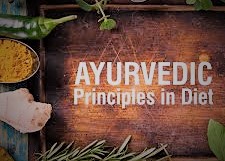
What makes food important, is it calories or nutrition? Or something else, like flavour, fads or appetite of a consumer. Diet prescribed on the basis of calories and nutrition, goes absolutely futile if appetite of a user, flavours of food and trending eating pattern are uncared for. Appetite being a physical entity enables to take food at on time and facilitate the process of digestion and assimilation of food. Flavour, essence, appearance or aroma and fads are the psychological entity which intern ignites the digestive fire (physical entity). Starters at the beginning and the desserts at the end of main meal are one of the fads which impart the ultimate contentment. So, it is must to consider these entities while stipulating the diet regimen.

āyurveda advocates food to an individual very systematically rather than advising the caloric food. Most of the modern dietician of the present era prescribes the diet on the basis of the calories rather than considering the unique physiology,state of mind, flavours and appetite, which act as the genuine impediments and really creates the nonsense in the theories advocated by the dietician. Advised food, even it may be more nutritious and according to the physical need of the person, but if it is not according to its appetite, flavour and uniqueness of the person, that food are useless and fails to achieve its goal. Because of these factors dietetic hypotheses goes vain and act as an obstacles in the way of managing the healthy and sick.
But, āyurveda says that, food is not only considered as the source of energy even it is considered as the source of illness too, when it is not consumed without considering the appetite (agni), quantity (mātravat) and quality (mitāhāra) according to āyurveda. These postulations are an exact contrast to the principles of caloric food intake which were prescribed by the contemporary sciences
Āyurveda classics like caraka samhita, suśṛuta Samhita , vāgbhaṭa stipulates certain basicprinciples while advising the diet to healthyand sick rather than saying caloric diet alone.
Those principles are dispersed extensively under the headings of

- aṣṭa āhāra vidhi viśēṣa āyatana,
- dvadaśa aṣana pravicāra,
- sapta āhāhra kalpana,
- āhāra pariṇāmakara bhāva,
- viruddāhāra,
- kṛtānna varga, etc.
Mainly these principles encompass
- āgni (digestivefire/appetite),
- mātra (Quantity),
- kāla (time offood consumption),
- hitāhāra (wholesomefood),
- sātmyā (habituated food),
- pathya(qualitative) and
- āhara saṃskāra (foodpreparation).
Along with these principles Ayurveda has intelligently utilized use of
- taste of substances (rasa),
- constitution of individuals (prakṛti) and
- bodily elements(dōṣa)
to modify impaired metabolism. Studies reveal reciprocal functioning of fundamental principles of Ayurveda, and modern genomics for development of predictive and personalized medicine. It has been established that biochemical variations of an individual depends upon prakṛti (constitution) and (constitution) aahar vishesh of food intake.
Food nourishes the body, mind and the spirit. Ayurvedic approach to food is based on the
fundamental principles of sensory perception
- gandha (odour),
- varṇa (colour),
- rasa (taste) and
- sparśa (tactile sensation).
As complex as this may seem, a rather simple dietary plan can emerge that incorporates all of the factors in a way that promotes optimal health. There are specific foods recommended for each constitution, but it is in harmonising the body and mind through the foods that health can be maximized or restored
Dietician theories goes vain when they start considering the factors like appetite, food flavours and the fads even after recommending the good nutritious and caloric food. Caloric and nutritious food if not initiating the appetite, if it fails to attract the consumer and if not according to the trend then no any individual will accept and consume it.
 So, it is very important to know the appetite of consumer, should follow the food preparation method which makes diet more flavorous and according to the current trend. Principles of Ahara namely the agni, matra and ahara samskara, prakruti, rasa, dosha, panchamahabhoota etc enumerated in the Ayurveda classics, guides the dietician to assess the appetite appropriately, matra helps to know the correct quantity of food, ahara samskara may enable to cook the more tasty food according to need and trend. These three basic principles of ahara help to serve the nutritious caloric food by fulfilling the flavours, fads and appetite of the individual.
So, it is very important to know the appetite of consumer, should follow the food preparation method which makes diet more flavorous and according to the current trend. Principles of Ahara namely the agni, matra and ahara samskara, prakruti, rasa, dosha, panchamahabhoota etc enumerated in the Ayurveda classics, guides the dietician to assess the appetite appropriately, matra helps to know the correct quantity of food, ahara samskara may enable to cook the more tasty food according to need and trend. These three basic principles of ahara help to serve the nutritious caloric food by fulfilling the flavours, fads and appetite of the individual.
It is well known that most diseases are related to impaired metabolism, the main reason being incompatible dietary habits. Goal of nutrition in Ayurveda is to restore and improve health through practices that lead to balance. This is achieved by following personalized guidelines according to one’s own constitutional make-up in terms of food, exercise, and other health-promoting measures.
Modern biomedical sciences are primarily concerned with stopping the symptoms or the effects. In some cases the cause is looked for, but as biomedicine system lacks the understanding of cohesive intelligence of the body, the cause is generally not understood. Unfortunately, biochemical nutrition cannot offer any method to work with individuals even though it knows this to be true. Not only are we at a loss of an individual nutritional model, we are also lacking a method to understand the universe as it is interrelated to the human being. The need is of a perfect combination of ancient Ayurveda with modern nutraceutical knowledge to overcome the practical constraints of diet and nutrition in both systems